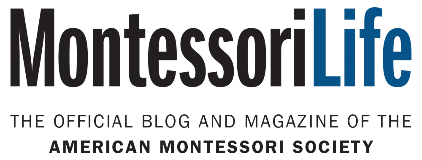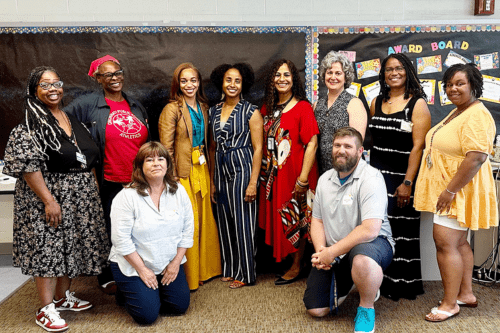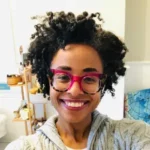Juanita Johnson, Dater Montessori
 As a veteran Montessori directress in Cincinnati Public Schools with over three decades of experience teaching Pre-primary (3–6-year-old) students, Juanita Johnson works diligently to raise consciousness and improve anti-bias, anti-racist practice in every space she inhabits. She is a diversity, equity, inclusion, and belonging champion who advocates for best practices to disrupt poor and harmful outcomes for students on the margins. Juanita has worked in many capacities, including as a teacher leader, teacher evaluator, and adjunct professor. She is a doctoral candidate in Educational Leadership at Northern Kentucky University. She has focused her scholarship on what it takes to forge an Anti-biased, Anti-racist, healing-centered Montessori practice in the 21st century.
As a veteran Montessori directress in Cincinnati Public Schools with over three decades of experience teaching Pre-primary (3–6-year-old) students, Juanita Johnson works diligently to raise consciousness and improve anti-bias, anti-racist practice in every space she inhabits. She is a diversity, equity, inclusion, and belonging champion who advocates for best practices to disrupt poor and harmful outcomes for students on the margins. Juanita has worked in many capacities, including as a teacher leader, teacher evaluator, and adjunct professor. She is a doctoral candidate in Educational Leadership at Northern Kentucky University. She has focused her scholarship on what it takes to forge an Anti-biased, Anti-racist, healing-centered Montessori practice in the 21st century.
Developing a tool that examines equity across teacher education programs and schools is complex work. Not to mention one rooted in Montessori philosophy and developed by Montessori experts in the field. It is essentially designed for us and by us. AMS is committed not only to ensuring the audit is accessible to all its members but also to strategically working directly with communities as they use it to support and implement positive change. Over the past year, I’ve collaborated uniquely with Montessori ABAR leaders across the country who are taking critical steps in raising consciousness and building capacity in their spheres of influence. The work is challenging, illuminating, and rewarding, which leaves us all as better people. I had the opportunity to reflect on collaborative work with a Montessori teacher leader with the goals of rolling out the Equity Examined audit tool school-wide, including administrative and parent leadership teams.
Please share why you are interested in the Equity Examined Audit tool.
When I think about freedom dreaming and vision casting, I think about the possibilities. The Equity Examined audit tool, along with your advocacy, has been instrumental in helping to shape a plan of how Dater Montessori can implement the tool in our Cincinnati public Montessori school.
In my dissertation, I reflected on leaving the AMS conference in Boston noting how overjoyed I felt to be in community with so many Montessorians of color. In Cincinnati, we’re so segregated. There are so few of us; we also don’t have an affinity space or anything like that yet. I always assumed that there weren’t many Montessorians of color. After leaving the conference, I was in heaven! The icing on the cake was leaving with this incredible tool that AMS has launched. I downloaded it, but I also bought it and I’ve got Post-it notes all over it!
Bringing the Audit back to our committee infused life into our strategic planning. It is our tool, designed for Montessorians from our governing organization! That’s a big advantage! A lot of people think, “Okay, anti-racist work is over here. DEI work is over there.” As if the work is separate and not integrated. Some think it’s not necessarily connected to our philosophy. So to have this tool that demonstrates that intersectionality is phenomenal! It automatically helps with buy-in because it comes from AMS, it is customized for us, by us and it is legitimate.
The tool is pretty expansive; it covers work with teacher education programs, school leadership, and individual program levels. How have you found it so far?
Initially, I didn’t know where to start, so we just decided to simply start at the beginning. We looked at the incredibly well-crafted anti-racism statement and mission statement on the first couple of pages. After studying the two statements and how comprehensive they were, we started dreaming about how we could adapt them to be used at our school.
Afterward, we launched into reading the essays in small groups., It was such a robust and expansive conversation that we couldn’t even get through our sharing. We had to do it throughout several meetings because people had so much to say and people were so interested; there was this generative dialogue and after experiencing that people wanted to get right to the audit.
I’m sharing that historical perspective because we went from reading the statements to discussing the essays as a whole staff, and then at whole team meetings for two months before another whole staff discussion. We ended the year by inviting other parents into the conversation, our peer leadership, and our parent leadership organizations, and it was indeed a dream come true. I wanted to pinch myself.
People felt comfortable to share statements like, “I thought we didn’t need this. I was like, why do we have to do this? But I’m so glad I came.” Also, to hear from voices typically quiet, when you’re not sure if they are being quiet because they don’t agree or they’re not interested, to hear them begin to contribute to the conversation in such a meaningful way was amazing.
What role did our collaboration play in rolling out your school’s equity work?
Our parents have been asking, “What can we do?” When we took the tool and pulled out the equity and justice-specific language from each group’s overall goals and purpose, we could see the light bulbs going off with each group., I could tell that there was genuine interest in making whatever adaptations needed to happen so that we could become more equitable.
At the end of this gathering, the sentiment shared by all was, “Listen, we need to build trust. We need to do this quarterly.” I felt equally overwhelmed and grateful that we were able to bring so many different people together. Schools, like many organizations, are so multifaceted, and they’re all these separate departments like cogs in a wheel. It’s very easy for one group to be doing something disparate from the other groups.
Having everybody on the same page, beginning to use the same language, and developing a shared understanding is critical and this has never happened. I think it may be part of the reason why our momentum has been low. With stakeholder buy-in and ownership of the mission, it gives us a better chance at reaching equity and inclusion for every child and educator. This is different from anything that’s happened in the past. Our collaboration with the Equity and Engagement department at AMS has been a breath of fresh air. It can be a challenge to have to hear from the same person over and over. Your approach was calming and very disarming; it felt like a friendly yet critical conversation. This form of communication was well received and helped with engagement as people let their guards down and were willing to explore vulnerable topics.
I want to just speak briefly again about the beauty of the essays because many of them brought up topics that aren’t commonly discussed. They helped to demystify our language. I found that many of our community members are hesitant to even say Black, Disabled, or Queer. These first-person essays gave us permission to read and reflect on someone else’s story who’s also a Montessorian, make connections, and most importantly, create a bit of safety for people to ask their questions and share their thoughts.
When we met as a whole staff, we always broke into smaller groups before sharing. The most transparent, vulnerable conversations happened in those smaller, more intimate settings. Then people would share and begin to connect with their own stories, which further disarmed other people and made them comfortable to be equally vulnerable. As peers and colleagues, people we love and care about began to share stories about themselves that maybe people didn’t know about their children or family members, this helped engender deeper empathy and a willingness to engage., For our next step, we launched with the essays and then looked at the leadership tool, which was also very helpful.
Now that a strong foundation has been laid and your community is engaged, what are your next steps?
So that’s part of why our next steps are clear. We needed to make sure that everyone understood what we were doing. We also needed to have clear committed communication with the entire school community. That drove a lot of action steps that helped us start to fill those gaps.
Our plan for next year is to continue these conversations and begin to integrate our learnings into the curriculum and practice at the classroom, and schoolhouse level. Another goal is to get clear about our structure and our strategic planning so that when we roll it out, or when we start to explore the audit tool deeper (which is what we hope to also do next school year), we have a good structure for that aligns with our committee’s structure and goals.
We have an upcoming meeting to revise our mission statement, while a subcommittee is looking at the school policy handbook, Student Handbook, and Code of Conduct student handbooks specifically about our no hoodies and no purses policy. We will be looking at how this policy targets specific children unfairly and will be considering if there is something else that we could do to get to the root of the concerns that create the need for people to feel like hoodies and purses need to be restricted.
We also received feedback on this student survey. The children shared their narratives about why they felt it was important so we have that qualitative data to support the request for this review. These are a few specific tasks on board and we look forward to using the Equity Examined book every step of the way!


